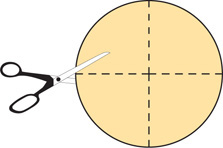Concept Byte: Exploring the Area of a Circle
Use With Lesson 10-7
ACTIVITY
You can use transformations to find the formula for the area of a circle.
Activity
-
Step 1 Use a compass to draw a large circle. Fold the circle horizontally and then vertically. Cut the circle into four wedges on the fold lines.

-
Step 2 Fold each wedge into quarters. Cut each wedge on the fold lines. You will have 16 wedges.

-
Step 3 Tape the wedges to a piece of paper to form the figure shown below. The figure resembles a parallelogram.

- How does the area of the parallelogram compare with the area of the circle?
- The base of the parallelogram is formed by arcs of the circle. Explain how the length b relates to the circumference C of the circle.
- Explain how the length b relates to the radius r of the circle.
- Write an expression for the area of the parallelogram in terms of r to write a formula for the area of a circle.
Exercises
Repeat Steps 1 and 2 from the activity. Tape the wedges to a piece of paper to form another figure that resembles a parallelogram, as shown below.

- What are the base and height of the figure in terms of r?
- Write an expression for the area of the figure to write a formula for the area of a circle. Is this expression the same as the one you wrote in the activity?
Table of Contents
- 6-1 The Polygon Angle-Sum Theorems
- 6-2 Properties of Parallelograms
- 6-3 Proving That a Quadrilateral Is a Parallelogram
- 6-4 Properties of Rhombuses, Rectangles, and Squares
- 6-5 Conditions for Rhombuses, Rectangles, and Squares
- 6-6 Trapezoids and Kites
- 6-7 Polygons in the Coordinate Plane
- 6-8 and 6-9 Coordinate Geometry and Coordinate Proofs




